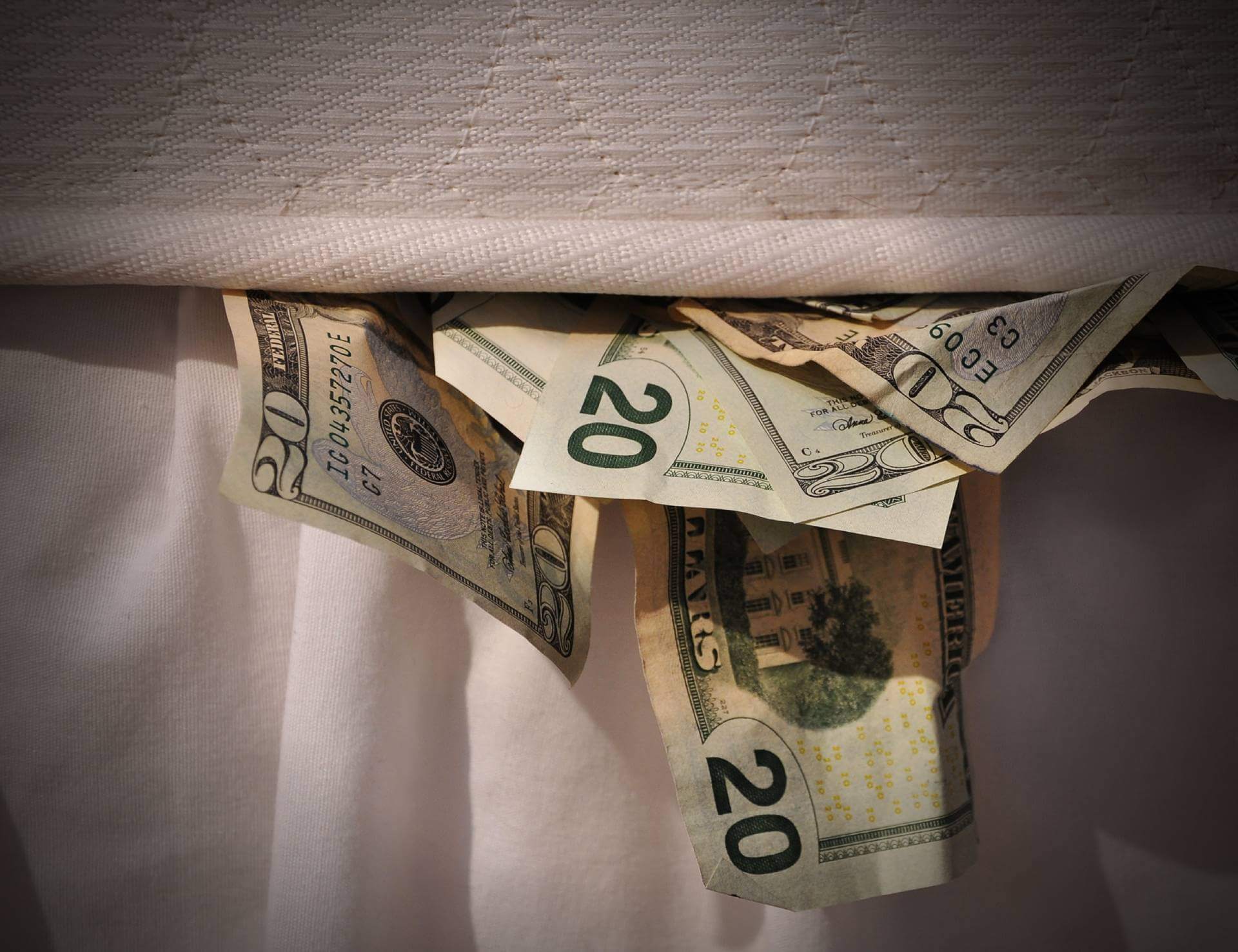Sometimes, it takes a tiny detail to shatter long-held beliefs.
We might wonder why glass is transparent, given that most other materials seem to stop light in its tracks without any effort. However, this perspective shifts dramatically when you envision an atom magnified to the size of a football stadium. In this atom, the nucleus, resembling a mere pea, resides at the stadium’s center while electrons whiz around the outer stands. The vast expanse in between is empty space. This revelation challenges our perception. Instead of pondering “Why is glass transparent,” we should inquire, “Why do most materials block light?”
A similar thing happens when we talk about money. Most of us think that we understand what money is, because we use it every day. A little bit of science will tell us that matter is really mostly empty space, and that money is really debt. Wow! But leave aside the abstract money that exists in banks’ computers. What about the cash in your wallet — at least we understand how that works, right?
Cash is not where you think it is
Recently, I stumbled upon a piece of information buried within the US Treasury Department’s quarterly “Treasury Bulletin.” The total amount of US currency, encompassing both coins and notes, currently stands at a staggering $2.3 trillion. But what’s really astonishing is that this amounts to a “per capita” figure of $6,998. That’s $6,998 for every man, woman and child in the United States. That ought to mean that, on average, a typical five-person family possesses an astounding $35,000 in cold, hard cash. Not in a bank account, but in the form of tangible currency.
Of course, we must account for other entities holding cash. Around $100 billion is kept in bank vaults. According to a study by JPMorgan, small and medium-sized enterprises (SME) hold, on average, $12,000 in cash. With roughly 33 million SME, the amount of cash can be estimated at $400 billion. Finally, there are around 450,000 ATMs (automated teller machines) in the US, with each holding, on average, around $20,000 in cash, or $9 billion in total. In addition, small amounts of currency will be found in vending machines, parking meters, and organizations receiving cash donations.
Sure. But this still leaves around $1.8 trillion behind — $5,375 per capita. This is hard to believe, since studies have shown that 64% of Americans would have to deplete their savings to cover a $400 emergency expense. So where is all the money?
According to an article published by the Federal Reserve Bank of St. Louis, an estimated 45% of all Federal Reserve Notes (paper cash), worth $1.1 trillion, are held by non-US persons. A study published by the Federal Reserve Bank of Chicago even suggests that more than 60% of all US bills and nearly 80% of $100 bills are held overseas. With $1.88 trillion in $100 bills outstanding, this would total up to $1.5 trillion.
The Federal Reserve makes money from foreign use of US currency
For the Federal Reserve, currency in circulation is a liability. You can conceive of a dollar bill as an interest-free debt note with no end date. Since it never has to be paid back, it is “free” debt.
Commercial banks have money in accounts at the Federal Reserve, which means the Federal Reserve owes them money. When they withdraw that money as cash, the debt is now represented by paper notes. By offloading its liabilities as currency in this way, the Federal Reserve can then invest its freed-up resources elsewhere. Income earned on such investments is called seigniorage. If invested in short-term Treasury bills, those profits can be described as risk-free.
With $2.3 trillion in currency outstanding, assuming the proceeds are invested in 1-month Treasury bills currently yielding 5.5%, the central bank would generate risk-free profits of $126.5 billion per year. This amount is larger than the military budget of all but China and the US itself.
Of those $126.5 billion, $88 billion would be earned thanks to dollar bills held by foreigners. That’s $88 billion the Federal Reserve is earning on safe interest. Foreign investors could have earned that money themselves if they had held Treasury bills instead of cash. So why would they forgo the money and allow the Federal Reserve to make the investments instead?
The answer is that US currency is quite useful.
In some countries, the US dollar is used alongside or even instead of the local currency for everyday transactions. This is usually the consequence of a substantial devaluation and loss of confidence in the local currency.
Ecuador adopted the US dollar as its official currency in the year 2000, following a severe financial crisis. Since then, the US dollar has been the sole legal tender in the country.
In September 2021, El Salvador became the first country in the world to officially adopt Bitcoin as legal tender alongside the US dollar. While Bitcoin is now a recognized currency, the US dollar remains the primary and most widely used currency for daily transactions.
Panama does not have its own national currency; instead, it uses the US dollar exclusively for all transactions.
Due to hyperinflation and the collapse of the Zimbabwean dollar, the US dollar, along with other foreign currencies, such as the South African rand and the euro, has been used for transactions.
In Argentina, lack of trust in local currency has led to strong demand for US dollars, resulting in a 100% premium for US dollar bills in black markets over the official exchange rate.
So, all of these countries make wide use of US currency as a means of exchange and as a store of value, and the Federal Reserve collects the profits.
Digital currency competes with stablecoins
However, this system only works as long as we are still using paper cash. As we shift towards a cashless society, those seigniorage profits will disappear!
This is one of the major reasons why all central banks are keen on introducing “central bank digital currency” (CBDC). Like cash, it would be money issued by a central bank (as opposed to bank deposits, which are money issued by a private institution). In a cashless society, CBDC would be the only way for citizens to get their hands on publicly issued money and for central banks to issue public money to citizens. The ability to continue to generate seigniorage profits depends on the successful introduction (and acceptance) of CBDC.
Here is where private issuers of stablecoins enter the scene. A stablecoin is a digital token that is designed to have a stable value, typically by being pegged to a reserve of assets or through algorithmic mechanisms, but which is neither issued by a central bank nor a commercial bank. Thus, stablecoins are direct competitors to CBDC.
Take Tether, for example. According to its website, Tether has issued almost $83 billion worth of tokens. Assuming the operation is not fraudulent, Tether invests proceeds received in exchange for the issuance of tokens in interest-bearing securities like Treasury bills. $83 billion invested at a yield of 5.5% results in interest income of around $4.5 billion per annum. Since Tether does not pay any interest on tokens issued, this interest income, after subtracting some administrative expenses, is profit. The business of stablecoin issuance is extremely profitable! Seigniorage profits, but privatized.
Since the Federal Reserve remits most of its profits to the US Treasury, seigniorage profits by the US central bank indirectly benefit US taxpayers. Privately-owned stablecoin issuers are eating into the cake of public seigniorage. And there are limited options on how to prevent private issuers from taking a growing share of the cake.
But stablecoins are not as trustworthy or easy to use as cash. So why would anyone forgo risk-free interest income on US Treasury bonds and instead hold a non-yielding stablecoin like Tether?
Stablecoins provide a means for crypto-currency traders to quickly exit the cryptocurrency market without the need to transfer funds back to a traditional bank account. This liquidity is particularly useful for arbitrage opportunities and active trading. In traditional banking and brokerage, proceeds from a sale are not immediately available for another trade, as settlement of funds does not take place until a few business days later.
95% of Tether, to the extent that we can tell, is held outside the US. Tether is likely gaining popularity in countries with failing local currencies for the same reasons we cited above for the use of US paper money abroad. For a person living in Argentina, unable to access dollars at the official exchange rate of 350 pesos to one dollar, and faced with a black market rate of 725 pesos, the remote possibility of a stablecoin issuer becoming insolvent pales in comparison with the certainty of 113% inflation in local currency.
From a regulatory perspective, stablecoin issuers are accepting deposits while lacking a banking license. Therefore, they cannot call themselves banks, and the deposits they hold are not covered by any deposit insurance scheme. The lack of transparency and high risk of fraud set stablecoin issuers apart from highly regulated commercial banks.
But what if a stablecoin issuer did act like a legitimate bank? If it were a member of the Federal Reserve System and deposited its proceeds into an account with the Federal Reserve Bank, the existence of funds would be easily verifiable. Moreover, since the central bank cannot go bankrupt, there would be no default risk!
Custodia Bank of Wyoming, a US state with crypto-friendly legislation, has tried for years to do exactly that by becoming a member of the Federal Reserve System. The Federal Reserve, however, recently denied Custodia Bank’s application as the firm’s “novel business model and proposed focus on crypto-assets presented significant safety and soundness risks”.
Seigniorage profits are substantial, especially if most holders reside outside the country of the issuing institution. The prospect of virtually risk-free gains will continue to attract privately owned stablecoin issuers. Central banks will try to prevent those private issuers from eating into their share of profits. Perhaps users will only stop flocking to stablecoins after a good proportion of issuers run into financial troubles, fall victim to theft from insiders, get hacked or see their peg to the underlying currency fail. Central banks probably wouldn’t shed many tears if that happened.
[Anton Schauble edited this piece.]
The views expressed in this article are the author’s own and do not necessarily reflect Fair Observer’s editorial policy.
Support Fair Observer
We rely on your support for our independence, diversity and quality.
For more than 10 years, Fair Observer has been free, fair and independent. No billionaire owns us, no advertisers control us. We are a reader-supported nonprofit. Unlike many other publications, we keep our content free for readers regardless of where they live or whether they can afford to pay. We have no paywalls and no ads.
In the post-truth era of fake news, echo chambers and filter bubbles, we publish a plurality of perspectives from around the world. Anyone can publish with us, but everyone goes through a rigorous editorial process. So, you get fact-checked, well-reasoned content instead of noise.
We publish 2,500+ voices from 90+ countries. We also conduct education and training programs
on subjects ranging from digital media and journalism to writing and critical thinking. This
doesn’t come cheap. Servers, editors, trainers and web developers cost
money.
Please consider supporting us on a regular basis as a recurring donor or a
sustaining member.
Will you support FO’s journalism?
We rely on your support for our independence, diversity and quality.







Comment